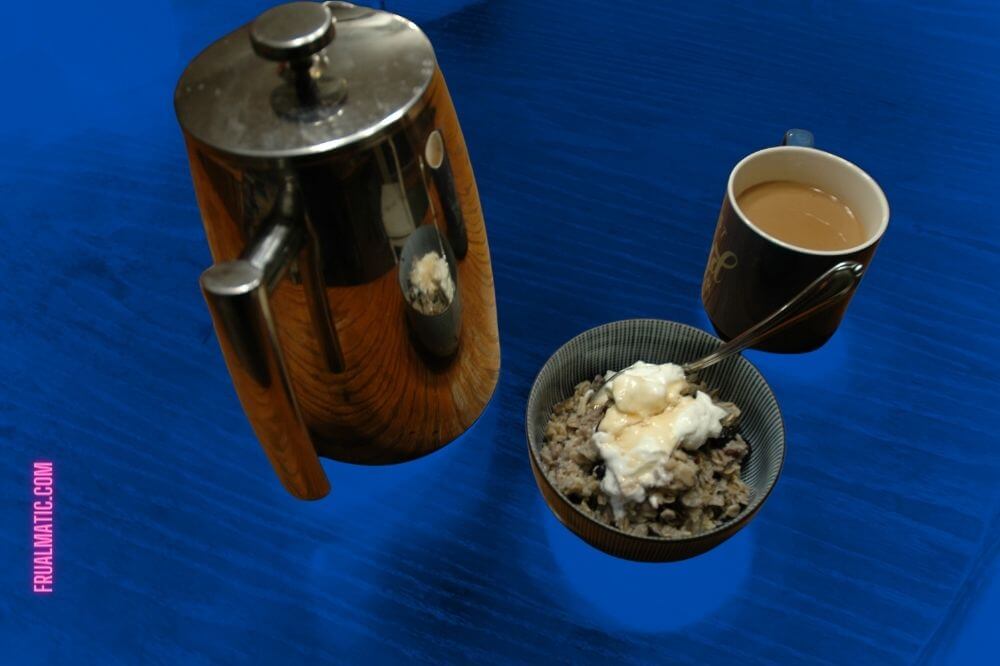This post was last updated on August 11th, 2022 at 11:04 am
The U.S. and much of the rest of the world are experiencing the highest rates of inflation in nearly 40 years. It’s particularly noticeable at the grocery store, where I recently saw a $3.99 gallon of milk—the generic brand! Our dollars are buying less and less these days, but the good news is you can fight inflation. By making small changes to your daily routine, it’s possible to save hundreds of dollars over the course of a year. All it takes is an open mind, some creativity, and persistence.
Fight inflation by multiplying your savings
Let’s use Starbucks coffee as an example. If I buy Starbucks every day on the way to work, it might not seem like I’m spending much, perhaps $2 a day. But it adds up: Multiply $2 by five days a week. Then multiply that amount ($10) by 52 weeks. That’s $520! And if you’re buying mochas, you can double it. By making coffee at home instead of buying it at Starbucks, it’s possible to save hundreds of dollars over one year. I’m not trying to pick on Starbucks (OK, maybe a little bit). My point is, small tweaks to your routine can have big effects.
Keep in mind, by spending less at places like Starbucks, you are also spending less on sales tax. If your local government charges a 5% sales tax, that $2 cup of coffee is actually $2.10. Over a year, your Starbucks bill would be $546 (not the $520 figure cited above) after accounting for the 5% sales tax.


But that’s not all. When you buy your coffee at a grocery store, you likely won’t pay sales taxes on it because many states don’t tax groceries. You’re essentially earning 5% interest by NOT spending money at places like Starbucks. Furthermore, your tax savings will keep pace with inflation as the price of that Starbucks coffee increases.
This sort of virtuous savings cycle can give your budget a big boost in an inflationary environment.
Your morning routine: ammo to fight inflation
The trick to taming inflation’s effects on your budget is to be consistent. If you stop buying Starbucks but then return to it after only a week, you won’t achieve substantial savings. Along with being consistent, it pays to be observant. If you can spot multiple expenses to cut, you’ll increase potential savings. To give you an idea of how you can go about finding these savings, I’ll spotlight my morning routine.
Let’s start in the bathroom, keeping in mind that personal hygiene is, well, personal. Some of the ideas shared here won’t work for everyone, or maybe even most people. But my goal here isn’t to have you follow this exact routine. Rather, my goal is to simply help you think about your own routine in search of opportunities to cut costs.
In the shower
Install a low-flow shower head. Many municipal utilities have increased water and sewer rates beyond the rate of inflation because they’ve neglected their infrastructure over the years and are now facing expensive repairs. In my experience, it’s not unusual for utility bills to increase by 10% or more in a year. An easy way to reduce water consumption is by installing a shower head that cuts down on water use.
In front of the bathroom mirror
Once you step out of the shower, there are a lot of opportunities to cut costs. I make do without any hair-care products other than a brush. Ask yourself, are there any you can eliminate without causing significant stress or lifestyle disruption?
Here are a couple more ideas to consider: Replace shaving cream with a bar of soap. For guys with light beards like mine, you can eliminate the shaving cream by shaving immediately upon exiting the shower. The moisture and heat generated by the shower softens whiskers enough to shave with a little lather from a bar of soap.
Deodorant selection
Salt is more than a food seasoning, water softener, and ice remover. It can also be deodorant, specifically a brand of deodorant called Crystal. One upside is that it’s free of chemicals, though their absence doesn’t make it less powerful. Salt works by preventing the growth of odor-causing bacteria. The salt itself is also odorless.
Perhaps the biggest benefit is this deodorant lasts a really, really long time. The company says: “Crystal Deodorant can last for more than a year of daily use.” In fact, you’ll likely break the deodorant case before you run out, as I’ve dropped mine a few times. I keep an eye out for sales and coupons and stock up periodically. Basically, I’m set for deodorant for years to come.
Manual vs. electric toothbrush
I’m not a big gadget guy, but I make an exception for the electric toothbrush. I’ve used one for years and believe it’s one of the reasons I’ve had few dental problems. But it’s more than my belief: One study shows that electric toothbrushes are 21% more effective at eliminating plaque than manual brushes.
You might be wondering: How would an electric toothbrush help me fight inflation (after all, it’s more expensive than the manual version)? Because it’s more effective, using an electric brush should result in, theoretically, fewer cavities and fillings. Just as important, fewer fillings means fewer complications down the line requiring procedures such as root canals. Ultimately, needing fewer procedures will save you money, potentially thousands of dollars over a lifetime.
And one more thing: Flossing is an absolute must.
At the bedroom closet
More people are waking up to the fact that clothes aren’t made to last (fast fashion). Fashion designers are in the business of changing fashion not so much because they care what you look like but because they want you to constantly buy new clothes. This might sound cynical, but I think the inferior quality of some clothing proves the point.
My advice is to get off the spinning fashion wheel. Instead of chasing the latest fads, buy clothes that stay in style. At the same time, focus on buying quality clothes, which might cost more in the short run but will reduce costs in the long run.
To the kitchen for breakfast
Pellets for fish
On a shelf next to our kitchen table lives Reddy. He’s a betta and has been with our family for nearly three years. To celebrate his birthday in April, we’ll give him two pellets of food just like he gets every morning. In fact, he’s been eating from the same 1-ounce, $2.50 container of food since we bought him for $5 in 2019. And there’s still plenty of pellets left.
Based on my calculations, it’s costing less than a penny a day ($0.003) to feed Reddy. And there’s no mess! It is a dream pet.
Don’t get me wrong, dogs and cats are pet favorites. However, you’ll never find a pet as economical as a fish. Talk to it, love it, and make it part of your family—for a fraction of the price!
Oatmeal and coffee for people
Once Reddy is fed, the rest of us eat. Our meals cost more than $0.003 a day, but we do save in two ways: oatmeal and a French press. Oatmeal is a relatively cheap way to get lots of nutrients. You don’t need to buy name brands, either, because oatmeal is oatmeal—at least in my world. I like to add a dollop of yogurt, maple syrup, and some blueberries to liven things up.
For coffee, the French press is great because you don’t need filters or those little cups for Keurig machines. The French press requires only two items: coffee beans and water. First, grind the beans. Dump them in the pot, pour in hot water, and then push down the plunger. Grinding the beans to a proper consistency takes some practice, and you have to be careful pushing down the plunger so you don’t splatter coffee everywhere. (I still sometimes make a mess, and I’ve been doing it for more than 20 years.) But you’ll get the hang of it.
Here’s another tip: Consider buying a stainless steel French press instead of a glass one. I’ve broken multiple glass ones along the way until I switched to a stainless steel one five years ago. No breaks since then!


The robusta beans in our pantry (gasp!)
Finally, I’ll make a controversial suggestion to further reduce coffee costs: Use cheaper brands featuring the much-maligned robusta bean. When purchased at a discount, these coffees can greatly stretch your coffee dollar. Admittedly, the robusta bean can produce a less flavorful, more bitter cup of java than its arabica counterpart. It is like trading steak for hamburger, but I sometimes buy robusta when the price spread between robusta and arabica gets too wide.
If you decide to buy robusta, I recommend trying a cold press. Stick your grounds in a pot and let them steep overnight in the refrigerator. Filter it in the morning and then heat it up if you wish. I find a cold press noticeably reduces bitterness levels.
Of course, the best way to cut your coffee budget is not to drink any. And kudos if that’s you. I’m not there yet (and probably never will be).
Read: Why buy BBQ sauce when you can go homemade?
To fight inflation: Multiply your savings
As you go about tweaking your routines, it’s important to find a balance between reducing costs and compromising your comfort. For instance, if drinking coffee from robusta beans is untenable, consider other ways to save on arabica beans. Again, the goal is to tweak your routine—not completely upend it. You want to be able to multiply those savings over time and experience ongoing benefits instead of one-time benefits.
In this post, we’ve touched on only a few possibilities for fighting inflation, and there’s still the afternoon and evening routines to consider (perhaps a topic for a future post). Hopefully, this gives you a good start. Make sure to share your ideas for saving money in the morning (or afternoon and evening) in the comment section below. We’d love to hear about them!

